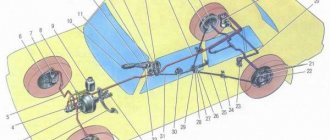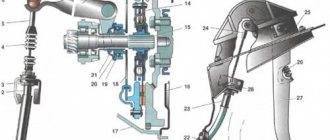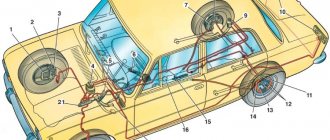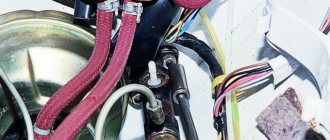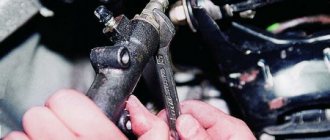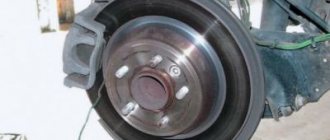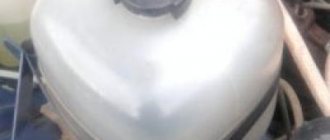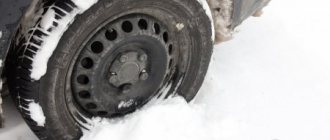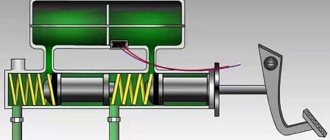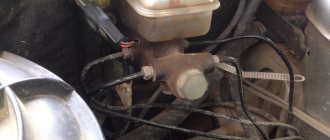The clutch is an important element in the design of a car, allowing you to “connect” the engine and gearbox, as well as realize the possibility of comfortable changing gears, eliminating shock loads, etc.
The clutch design on different cars may differ, while modern vehicles often use a hydraulic clutch. Among the main components of the hydraulic clutch system, the main cylinder (clutch master cylinder) should be highlighted.
The purpose of such a cylinder (sometimes called the clutch release cylinder) is to effectively transfer force from the clutch pedal to the clutch release fork. This fork presses the release bearing, which allows this mechanism to operate due to interaction with the clutch basket petals.
Specifications
In the specifications for the master cylinder, manufacturers indicate the following parameters:
These characteristics can be taken into account as auxiliary information when selecting a master cylinder for your car. Car enthusiasts pay special attention to manufacturing materials: the most common today are cast iron and aluminum, and there are also quite a few offers of cylinders with polymer bodies. Steel cases are quite rare, since steel combines high price and difficulty in processing.
Clutch master cylinder failure
The simple design and the absence of complex “filling” make the clutch master cylinder resistant to damage. Its main enemy is time, since even very high-quality parts wear out from constant loads (and the load on the clutch during city driving is an order of magnitude higher than during long trips).
The first thing that fails is the rubber parts. These are boots that fit onto the rod and protect the cylinder from abrasive particles, as well as sealing collars that prevent fluid from leaking out.
The weak point is also the spring inside the cylinder, which bears a serious load. Due to work and exposure to brake fluid, the quality of the metal deteriorates over time and the spring bursts (sometimes falling apart into several parts).
To replace worn parts, they sell special repair kits for the cylinder head, which contain everything necessary for updating and further operation of the cylinder.
If problems arise with the operation (torn seals were not replaced in time, installed incorrectly, the fluid was not changed, etc.), the cylinder mirror wears out: abrasions and scuffs appear on the metal, corrosion, after which the master cylinder begins to provide various “special effects” to the car enthusiast. In advanced cases, no repair will help, only replacing the entire spare part.
Clutch master cylinder: principle of operation, malfunctions, repairs
The clutch is an important element in the design of a car, allowing you to “connect” the engine and gearbox, as well as realize the possibility of comfortable changing gears, eliminating shock loads, etc.
The clutch design on different cars may differ, while modern vehicles often use a hydraulic clutch. Among the main components of the hydraulic clutch system, the main cylinder (clutch master cylinder) should be highlighted.
The purpose of such a cylinder (sometimes called the clutch release cylinder) is to effectively transfer force from the clutch pedal to the clutch release fork. This fork presses the release bearing, which allows this mechanism to operate due to interaction with the clutch basket petals.
Signs of a GCS malfunction
When problems begin with the master cylinder, it most often manifests itself as a hydraulic fluid leak. When the clutch pedal begins to work poorly, the first stage of diagnosis will be a visual inspection: any leaks on the cylinder and even just slightly moistened seals are a sign of a problem that needs to be solved.
Basically, when there are problems with the cylinder, the clutch pedal begins to sink or move slowly, and the pedal “sticks” in the lower position.
Another problem with the GCS is clogging of the holes in the tank lid. For normal operation, the level in the cylinder reservoir must rise and fall freely, and for this purpose, ventilation holes are provided in the cover. If they become clogged with dirt, the hydraulic drive begins to work with difficulty: the pedal becomes stiffer and does not return well to its original position.
A few words about hydraulic fluid
The hydraulic clutch usually uses brake fluid that has a set of characteristics that are optimally suited for the given task. For the operation of the system, what is primarily important is a sufficient fluid level, which can be determined by looking at the reservoir on the master cylinder. If for some reason there is less brake fluid, top it up without waiting for problems to appear.
When working, you need to remember that brake fluid is quite aggressive to plastic, fabric, paintwork and even leather. So you need to work with it carefully, and immediately wipe off any drips or drops on parts or the car body with a clean napkin. For the same reason, you need to monitor the condition of rubber parts that come into contact with the brake fluid: they can deteriorate very quickly and literally dry out under the influence of aggressive chemicals for which they are not intended.
And, of course, you need to add brake fluid to the system in a clean, closed room (garage or auto repair shop) so that dust does not get inside.
An interesting property of brake fluid is its very good penetrating effect, due to which it seeps out through microscratches on the cylinder surface or piston, even if the rubber seals are replaced. For this reason, the repair kit includes a new piston, and scratches and abrasions inside the cylinder become a clear indication for replacing the entire part.
Causes and symptoms of GCS malfunction
As mentioned above, wear and tear of individual cylinder elements is inevitable over time. Also, premature failure of a part can be caused by untimely replacement of brake fluid, ruptures of seals, errors in assembling/installing individual spare parts from the repair kit, etc.
The fact is that one of the properties of brake fluid is high penetrating ability. This means that fluid seeps through even the smallest scratches on the cylinder bore and/or piston. Replacing only the rubber seals does not help in this case.
Often, a high-quality GCS repair kit usually has both cuffs and a new piston. However, if there are scratches on the cylinder mirror, in this case the entire part needs to be replaced. For this reason, it is important to prevent critical wear and tear by paying attention to the slightest signs of failure of the main circulation system. As soon as a problem occurs in the cylinder, fluid can leak out of the system and its level decreases.
Interesting fact: where does sand come from in the clutch drive?
Sometimes auto mechanics repairing the clutch drive see a sediment in the brake fluid that resembles small grains of sand. There seems to be nowhere to get sand in such quantities.
The reason for the appearance of sediment is that most brands of brake fluid are unstable to electrical influence, and when exposed to even very low voltage, some components of the fluid precipitate (crystallize). But where does the electricity come from in the system if the wiring is in good condition?
As it turns out, the cast-iron cylinder body and aluminum piston create a small electrical potential in the presence of brake fluid, which is why crystallization of the fluid elements begins. For this reason, many manufacturers make pistons from polymer alloys, which, in addition to neutral interaction with metal, also have a reduced impact on the cylinder bore. The second option is a brass piston, but the price of such a part can scare off even the most daring buyer.
For a longer service life of the entire hydraulic clutch system, there is nothing better than timely replacement of brake fluid, because over time it also develops anti-corrosion additives and turns into an aggressive oxidizer. With regular maintenance, the system will not be damaged by daily standing in traffic jams, cast-iron-aluminum parts, or other loads.
For more information on how to select a new clutch master cylinder, read the Buyer's Guide article.
Source
Tips and tricks
Let's start with the fact that the working fluid in the clutch hydraulic drive is brake fluid (BF). The specified liquid is well suited to perform its assigned functions, is characterized by low price and availability, as well as ease of replacement.
It must be taken into account that such a liquid is a strong poison for living organisms and is aggressive towards plastic and rubber products, paintwork, etc. It is not difficult to guess that rubber seals quickly become unusable from contact with brake fluid (drying out and cracking occurs).
Brake fluid also tends to accumulate moisture over time (it is hygroscopic). This leads to both deterioration of its properties and the development of corrosion of parts with which it comes into contact.
The fact is that TJs are not resistant to electricity. In practice, even low voltage leads to precipitation and active crystallization of the constituent elements of the liquid occurs.
Please note that if the GCS is made of metal (for example, has a cast iron body), and the piston-cylinder is made of aluminum, a small electrical potential is created as a result of contact with the brake fluid.
This leads to the formation of sediment. To avoid crystallization of the fuel fluid, you need to choose a replacement GCS with a piston made of polymers. This piston is distinguished by the fact that it does not interact with the metal of the housing and has less impact on the cylinder bore. You can also pay attention to the brass piston, however, the cost of the part is very high compared to analogues.
For this reason, it is optimal to change the brake fluid once a year or every 20-25 thousand km. mileage This approach allows you to extend the service life of brake and clutch cylinders.
Finally, we note that you need to add brake fluid so that dust, dirt and debris do not get into the reservoir. Otherwise, small particles can act like an abrasive, quickly damaging the smooth and sensitive internal surfaces of brake and clutch components.
Squeezing the clutch before starting the engine: when you need to squeeze the clutch and in what cases it is not recommended to do so. Useful tips and tricks.
How to change gears without a clutch: driving a manual car without a clutch in case of malfunction. Tips and tricks.
Car clutch: purpose, types, design, principle of operation. Frequent clutch malfunctions in the vehicle transmission system, signs of problems.
Why the speed drops and the engine stalls when the clutch is depressed: possible causes of the malfunction. Diagnosis of the problem, checking, replacing individual elements.
How is the clutch implemented in the transmission device on cars with automatic transmission compared to a manual or robotic transmission. Features and differences.
How to use the DSG gearbox and save resource, as well as increase service life. Features of operating a robotic gearbox with two clutches.
Source
Installation, repair and replacement of the clutch master cylinder
If we simplify the formulation of the actions performed by the clutch drive, it will sound like this - the transmission of torque from the motor to the corresponding gearbox shaft with the ability to disable and then softly engage after switching to the desired gear. Nowadays, designers have not yet come up with anything more effective for achieving this goal than a hydraulic clutch drive. The diagram and principle of operation of the described device is simple: a depressed pedal acts on the clutch cylinder rod, which, accordingly, using hydraulic fluid located in the tank through tubes, activates, through the working cylinder, the fork and the release bearing.
Failure of the clutch drive occurs for several reasons, one of which may be a faulty clutch master cylinder; in order to repair it, it is advisable to understand its structure, signs indicating the inoperability of the mechanism, methods of repair, and if repair is not possible, then how to make it replacement.
What is a clutch master cylinder?
Clutch master cylinder (MCC) is a hydraulic drive unit for engaging and disengaging the clutch of manually controlled transmissions (manual transmissions); a hydraulic cylinder that converts the force from the driver’s foot into the pressure of the working fluid in the drive circuit.
The hydraulic clutch is one of the main components of the hydraulic clutch drive. The main and working cylinders, connected by a metal pipeline, form a sealed hydraulic drive circuit, with the help of which the clutch is turned off and on. The main clutch is installed directly behind the clutch pedal and is connected to it by a rod (pusher), the working cylinder is mounted on the clutch housing (bell) and is connected by a rod (pusher) to the clutch release fork.
The master cylinder plays an important role in the operation of the transmission; if it breaks down, driving the vehicle becomes difficult or completely impossible. But to make a purchase of a new cylinder, you need to understand the design and features of this mechanism.
Repair work
If the pedal fails, in order to avoid unreasonable disassembly of the cylinder, it is worth initially pumping the system and expelling air from there that could get in when the liquid in the tank drops below the minimum permissible level. If this does not help in principle, it is worth starting repairs. For this case, there is a repair kit for the clutch master cylinder on sale, which, depending on the make of the car, contains the main wearing parts: cuffs, return spring, rod, retaining ring, etc.
The master cylinder is located under the clutch pedal. Depending on the car model, dismantling will have to be done either from the engine compartment or from the car interior, having previously dismantled the floor covering in the driver’s area. Having removed the clutch master cylinder, we begin disassembling it, after which we need to wash all the parts. During the subsequent inspection, after disassembly, it is worth paying special attention to the body and the condition of the rod and mirror; if there are visible scuffs, this may indicate the appearance of wear in the cylinder or wear of the rod.
In general, experienced craftsmen recommend changing all the parts in the repair kit, especially the cuffs.
When repairing the clutch master cylinder, it is advisable to follow some tips:
If faults are found that cannot be eliminated with the spare parts contained in the repair kit, then a complete replacement of the clutch master cylinder is necessary.
Installation and replacement
Removing the clutch master cylinder is carried out in the following order:
- Pumping out the working fluid from the reservoir using a bulb or other device.
- Loosen the hydraulic hose clamp and disconnect it from the drive fitting.
- Unscrewing the hydraulic drive fitting.
- Unscrewing the nuts of the studs securing the drive to the car body.
- Removing the cylinder.
Installation of the product occurs in the reverse order. After installation, to bring the cylinder and the entire system into working condition, process fluid is poured into the tank and pumped.
When installing the clutch master cylinder, special attention is paid to ensuring the tightness of the connection between the hoses and the tube that supplies pressure to the slave cylinder.
If the connections are not properly sealed, fluid leaks and air enters the system, which leads to incomplete disengagement of the clutch or complete cessation of its operation.
Work performed when replacing the clutch master cylinder
The procedure required when replacing the clutch master cylinder is simple:
For the clutch bleeding procedure you will need:
To pump, you should: remove the protective cap from the valve, put a hose in its place, the second end of which should be lowered into the liquid in the container. Have an assistant press the clutch pedal several times and then hold it down. After turning the valve 4-5 turns, let the liquid with air bubbles drain out and screw the valve back. After performing the same actions several times, you should pump the system until all air is removed from it.
We also recommend watching videos on the topic:
Source
Clutch cylinder design: a little theory for successful practice
Issues discussed in the material:
The main structural elements of cars include such a unit as the clutch. It provides the connection between the gearbox and engine necessary for the vehicle to move. In addition, the clutch operation allows you to comfortably change speeds, eliminating shock loads. It is impossible to operate machines with a broken clutch. The failure of this unit can be due to a number of reasons. To eliminate such a malfunction, in most cases you need to know the design of the clutch cylinder, have experience in diagnosing the system and understand the features of replacing or repairing the mechanism.
Clutch system: structure and functions
The clutch is an integral element of any car, and the principle of its operation is approximately the same for all brands of cars. This unit enables/disables rotation transmission from the engine to the gearbox, which is a necessary condition for changing gears. The clutch design contains a number of elements, the control of which requires efforts that significantly exceed the physical capabilities of an individual person.
To simplify the control of this unit, a hydraulic drive was introduced into its design. Thanks to this solution, the driver can, without much effort, by pressing the clutch pedal, turn off the transmission of rotational force from the power unit to the gearbox (such a shutdown is necessary to stop the car and change gears while driving).
The hydraulic drive also ensures smooth switching on/off of gearbox speeds. The main elements of such a drive include the clutch master cylinder.
The clutch drive, based on hydraulics, which is equipped with different brands of cars, includes the following parts:
Clutch hydraulics are not fundamentally different from hydraulic drives of other vehicle systems (for example, brake system hydraulics). The operating principle of the hydraulic drive is based on the properties of the fluid, which practically does not compress at high pressure, but effectively transmits force to the actuators.
Clutch master cylinder design
There are several main types of clutch master cylinders available in different car models. They all have a similar design and the same principle of operation, but may differ in the type and location of the expansion tank, as well as in the number of pistons and type of housing.
Depending on the location and design of the reservoir, there are 3 types of clutch master cylinders:
The first type of master cylinder device is more common on older car models. In this case, the device structure is placed vertically or at a certain angle so that the container is located at the top of the cylinder. In this case, the volume of brake fluid is compensated from the reservoir, which is located outside the cylinder body.
The second and third design options for the clutch master cylinder are a more modern type of device. They differ in the location of the tank. In the second option, it is placed outside the master cylinder and connected to it using a hose. The third option for the design of automobile clutch cylinders involves the location of the reservoir on the body of the clutch master cylinder (MCC).
We recommend
The GCS design may contain 1 or 2 pistons. If the cylinder is equipped with one piston, then the pusher associated with it ensures that the force generated when pressing the clutch pedal is transmitted directly to the brake fluid. If there are 2 pistons, they are functionally divided into main and intermediate. In this case, the pusher sets in motion the intermediate piston, which affects the main one, which transmits force to the working fluid of the hydraulic clutch drive.
Another design option for the clutch master cylinder differs in that it is connected into a single housing with the master cylinder of the brake system. Such structures can be placed vertically, horizontally, or at a certain angle.
The simplest device is for clutch master cylinders, which have a remote reservoir that is installed on the body of the part. Such GCS have a cast body in the shape of a cylinder with eyes for fastening bolts. At one end of the housing there is a threaded plug or plug with a built-in fitting, which is connected to the hydraulic drive pipeline. In GCS closed with a blind plug, the fitting is located on the side surface of the cast body.
In the middle part of the main clutch housing there may be a fitting that provides a connection to the reservoir or a place for attaching the reservoir directly to the clutch master cylinder body. At the point where the fitting is installed and the expansion tank is attached, there are 2 technological holes: inlet (compensation) and bypass. The inlet hole is smaller in size compared to the bypass hole. These technological holes are located in such a way that when the clutch pedal is released, the inlet is in front of the piston (from the side of the hydraulic drive circuit), and the bypass hole is after the piston.
There is a piston and pusher located inside the clutch master cylinder housing. The last element of the main circulation center is connected to the clutch pedal.
The master cylinder body in the part where the pusher is located has a corrugated protective cap made of special rubber. In the free state of the pedal, the return spring, which is built into the body of the main circulation center, moves the cylinder piston to its extreme position. The dual-piston master cylinder design includes a special O-ring that is located between the sequential intermediate and main piston. The two-piston device improves the tightness of the hydraulic drive and, accordingly, increases the reliability of the system.
Let's look at the principle of operation of the clutch master cylinder. When the pedal is released, the return spring moves the piston to its extreme position. At this moment, the pressure in the clutch hydraulic drive system is equal to atmospheric pressure, since the working cavity of the GCS is connected to the expansion tank through the inlet. When the driver depresses the clutch pedal, the piston receives force and begins to compress the working fluid in the hydraulic drive line. As the piston moves, it closes the inlet port, which leads to an increase in pressure in the circuit. In this case, the working fluid moves through the bypass hole behind the piston on the reverse side. An increase in pressure in the hydraulic drive line promotes further movement of the piston, which acts on the fork that disengages the clutch. The fork, in turn, acts on the release bearing and the clutch disengages. At this moment the driver can change gear.
When the driver releases the clutch pedal, the master cylinder piston returns to its initial position, the pressure in the line decreases and the engine’s clutch with the gearbox is disengaged. When the piston moves to its original position, the working fluid that is located behind it is squeezed out through the bypass hole. As a result, the piston movement slows down, which facilitates smooth engagement of the clutch.
As a result of a leak in the line due to insufficient joint density or other defects, leakage of the working fluid may occur. In this case, the required volume of liquid is replenished from the tank through the compensation hole in the main cylinder body. In addition, the inlet allows you to maintain a stable volume of working fluid in the line during its thermal expansion/contraction.
The design and principle of operation of the clutch master cylinder with an integrated reservoir have their own characteristics. In this case, the cast body is positioned vertically or at a certain angle. The reservoir for the working fluid in such a cylinder is located in the upper part of the housing. Below this is a spring-loaded piston, and a pushrod passes through the reservoir, which is connected to the clutch pedal. The reservoir may have a separate plug for adding working fluid, or a fitting connected to a separately located expansion tank.
There is a recess in the upper part of the master cylinder piston, and a hole with a small diameter is drilled along the entire piston, above which the pusher is located. When the piston is retracted, there remains a small distance between it and the pusher, through which working fluid enters the working cylinder.
Let's look at the operating principle of a clutch master cylinder with an integrated reservoir. When the pedal is released, the pressure in the working fluid line is equal to atmospheric pressure, and the clutch is in the engaged state. When the pedal is depressed, the pusher, moving down, closes the hole in the piston, which ensures the tightness of the system. The pusher, in turn, presses on the piston, which increases the pressure in the line, and the working cylinder acts on the clutch release fork. When the driver releases the clutch pedal, all processes in the hydraulic drive system occur in reverse order. Possible leaks of the working fluid and its thermal expansion are compensated by a hole in the piston.
Design and principle of operation of the GCS
To begin with, a hydraulic clutch consists of a pair of cylinders (clutch master and slave cylinders) that allow the clutch to operate hydraulically. As for the master cylinder, the design of the main cylinder and its operating principle is as follows:
- the force from the clutch pedal is transmitted through the pusher to the rod. Next, the piston extends, as a result the valve closes, as a result of which the liquid from the part of the cylinder where it is compressed is able to flow into a separate tank;
- the liquid compressed in the cylinder is pushed through the fitting, after which it enters the hydraulic line, through which it is supplied to the working cylinder;
- the working cylinder acts on the fork, transmitting force to it. After the driver releases the clutch pedal, the piston of the cylinder returns back using a spring.
As you can see, the clutch hydraulic drive works similarly to other systems (for example, the hydraulic brake system), which are based on a fluid that is almost not compressed under pressure, but there is an effective and quick transfer of force to the actuators.
Please note that when choosing a new part, you must take into account individual technical characteristics, method of fastening, connection, the presence of a tank in the kit, body material, dimensions, rod length, fitting diameter, etc.
In other words, when choosing a master cylinder for a particular car, you need to take into account a number of parameters and features. It is also recommended to pay special attention to the material of manufacture. The fact is that cylinders can be either steel, aluminum or cast iron, or plastic (made from polymers).
Products made of cast iron and aluminum are quite common and are an “average” option in terms of quality; plastic cases are the most affordable, but are not always reliable and have a long service life. As for steel, such cylinders are the most reliable, but have a high cost due to the complexity of manufacturing.
Signs and causes of clutch master cylinder malfunction
Even a simple design of the clutch slave cylinder cannot serve as a guarantee against various malfunctions that prevent it from effectively performing its functions:
If any signs of malfunction of the clutch master cylinder are detected, it is necessary to diagnose not only this unit, but the entire system. Troubleshooting in the early stages allows you to limit yourself to replacing individual parts.
The most significant malfunctions include defects in the cylinder surface - scuffs, scratches, corrosion, etc. When they are identified, it is most often necessary to replace the clutch master cylinder assembly.
Since the brake fluid used in the clutch hydraulic drive has good penetrating ability, if defects appear on the surface of the master cylinder, it will quickly leak even through micro-cracks, so installing new seals will not eliminate the leakage.
We recommend
The brake master cylinder repair kit includes cuffs and a working piston. Replacing these elements will not eliminate the problem if there are scratches on the surface of the clutch cylinder itself. Taking this circumstance into account, the main circulation system should be checked periodically in order to identify malfunctions at an early stage and prevent critical wear of the part. The appearance of defects in this unit may be indicated by a decrease in the liquid level in the expansion tank caused by its leakage.
At the same time, the clutch pedal itself begins to move worse, and disturbances when switching gears caused by improper operation of the clutch hydraulic drive become noticeable. Due to a malfunction of the main circulation system, the pedal often falls and moves more slowly.
If the signs described above are present, you should carefully inspect the main fluid pump for leaks, check the level of the working fluid and its quality. The presence of streaks on the cylinder body or wet spots on the cuffs indicate a lack of tightness of the clutch hydraulic drive.
Malfunctions in the operation of the main circulation system can be caused by clogged ventilation holes in the expansion tank cover. The clutch drive device is designed in such a way that it maintains a constant volume of fluid. When the pressure in the system increases or at high temperatures, the level of the working fluid increases and then gradually decreases.
To adjust the fluid level, special holes are equipped in the cover of the clutch expansion tank. If the ventilation of the hydraulic drive is clogged, it begins to malfunction. In this case, the clutch pedal will be depressed quite tightly, and its return to its original position will be slower.
Clutch master cylinder malfunctions
Despite the simplicity of the device, the clutch master cylinder may have the following breakdowns that make its normal operation difficult or impossible:
- Lack of process fluid. The liquid level in the tank must be periodically monitored and, if necessary, topped up to the set level. It appears when the cuff on the cylinder is damaged or broken or the system connections lose their tightness. Eliminated by identifying the location of the leak and ensuring its tightness.
- The entry of air into the system, leading to failure of operation, which is manifested by “under-depressing” of the clutch with a characteristic crunch or vibration of the lever when changing gears. The cause of the malfunction is cracks in the tubes, wear of moving parts or leakage of the system at the connections. The malfunction can be resolved by identifying and eliminating such areas and bleeding the entire system to remove any air trapped there.
- Pumping liquid through oneself. The malfunction occurs when the cuffs fail or there is wear on the piston itself. Eliminated by replacing damaged parts.
The first signs of a malfunction should serve as a reason to diagnose the clutch master cylinder and the entire system as a whole. Timely measures taken will allow you to avoid replacing the entire assembly by eliminating the malfunction by replacing worn parts.
Checking and repairing the clutch master cylinder
Since the GCS does not have a very complex device, if you have minimal skills, you can repair it yourself without contacting a car service. The time spent on servicing this unit will ensure reliable operation of the clutch and trouble-free operation of the vehicle.
Diagnosing clutch master cylinder faults is a simple and not very labor-intensive process. It is necessary to periodically inspect the device to detect leaks of working fluid and to identify visible defects. When checking the main circulation system, you also need to check the level of the working fluid in the tank.
You can diagnose the master cylinder yourself in a matter of minutes. If the unit has leaks, they will be visible to the naked eye, and the level of clutch fluid in the expansion tank will decrease. Most often, in the event of such malfunctions, you can avoid replacing the entire device, since sorting out the main circulation system is a task that most car owners can do.
If the car is operated intensively, the driver should pay attention to various aspects of the clutch operation, which may indicate problems with the master cylinder. Experts include these signs:
Even if you find only one symptom from the list described here, you need to stop using the car and diagnose the clutch master cylinder and then eliminate the identified faults.
Important
. If the clutch pedal fails, first of all, it is necessary to bleed the hydraulic drive to remove air from the line (it could enter the system as a result of the fluid level in the expansion tank dropping below the minimum permissible value). If bleeding the line does not help eliminate the problem, you need to start disassembling the master cylinder. For this device, you can purchase a GCS repair kit (depending on the modification of the car, such a kit may contain seals, a rod, a spring mechanism, a retaining ring and other wearing elements).
As noted earlier, the GVC is located at the bottom of the clutch pedal. In different car models, removal of this device can be done from the engine compartment or from inside the car (in this case, it will be necessary to remove the interior trim from the floor in the driver's area).
To dismantle the clutch master cylinder, it is necessary to unscrew the cap of the expansion tank and remove the rubber gasket, which protects the hydraulic drive line from air penetration and also helps to create excess pressure. Then, using a syringe, you need to remove all the working fluid from the expansion tank (this is necessary to prevent splashing of the brake fluid during the process of dismantling the brake fluid pump).
Now you need to install the mounting location for the master cylinder. This stage causes certain difficulties, since getting to this place in many car models is quite difficult. Usually it is located in the car’s interior where the main circulation system goes into the engine compartment.
For further work, you need to prepare plugs that can be used to plug the hoses so that the working fluid does not leak out of them. After this, you can disconnect the hoses from the fittings, the tubes from the main circulation pump and plug the hoses.
At the next stage, we move on to unscrewing the nuts securing the main hydraulic center to the car body. It should be noted that this procedure can cause some difficulties due to difficult access.
When the GCS is removed and completely disassembled, you will need to thoroughly wash and dry all the parts of this device, and then evaluate the technical condition of each element. First, check the integrity of the piston “mirror,” as well as the cuffs and seals. If there are traces of corrosion on the master cylinder parts, they should be removed using fine-grained sandpaper. If there are many such areas, and there are scuffs on some surfaces, then this may indicate a discrepancy in the clearance between the surface of the main fluid circulation housing and the piston.
We recommend
All sealing elements should be checked especially carefully, and as practical experience shows, it is advisable to replace them with new ones. It happens that there are no visible defects on the cuffs, but after reinstallation they begin to leak working fluid.
Qualified mechanics advise replacing all components of the main circulation system presented in the repair kit.
After replacing the necessary parts and eliminating any detected faults, the main cylinder is assembled in compliance with the order of assembly of all parts.
Recommendations for repairing the GCS:
It is worth noting that in order to perform operations to disassemble the central hydraulic system, it is necessary to have an understanding of the structure of this unit and minimal skills in plumbing work. If you do not meet these conditions, it is better to contact experienced specialists or replace the master cylinder assembly.
Types of Clutch Master Cylinders
All GCS have a fundamentally identical design and principle of operation, but are divided into several varieties according to the location and design of the reservoir with the working fluid, the number of pistons and the general design of the housing.
According to the location and design of the tank, the cylinders are:
- With an integrated reservoir for working fluid and a remote tank;
- With a remote tank;
- With a reservoir located on the cylinder body.
| Clutch master cylinder with integrated reservoir | Clutch master cylinder with remote reservoir | Clutch master cylinder with reservoir mounted on housing |
The first type of GVC is an outdated design that is rarely used today. Such a mechanism is installed vertically or at a certain angle; in its upper part there is a reservoir with working fluid, the supply of which is replenished from a remote tank. Cylinders of the second and third types are more modern devices, in one of them the tank is remote and connected to the cylinder via a hose, and in the other the tank is installed directly on the cylinder body.
Based on the number of pistons, GCS are:
- With one piston;
- With two pistons.
| Single piston clutch master cylinder | Clutch master cylinder with two pistons |
In the first case, the pusher is connected to one piston, so the force from the clutch pedal is transmitted directly to the working fluid. In the second case, the pusher is connected to an intermediate piston, which acts on the main piston and then on the working fluid.
Finally, GCS can have various design features, for example, on some cars this device is made in a single housing with the main brake cylinder, and the cylinders can also be located vertically, horizontally or at a certain angle, etc.
How to bleed the clutch system
After repairing or replacing the hydraulic clutch, you always need to bleed the hydraulic clutch drive. This procedure will eliminate air bubbles from the line that interfere with the normal operation of the clutch. When carrying out repair work, air always gets into the hydraulic drive line and creates problems in the operation of the clutch. The pumping process does not take much time and does not cause any particular difficulties. In car services, when replacing a brake cylinder, powerful vacuum pumps are used to remove air from the line, so you can do without bleeding the clutch drive.
We recommend
To bleed the clutch hydraulic drive yourself, you should place the car in a pit or lift it on a lift - this will simplify access to the master cylinder. A new “brake fluid” should be poured into the expansion tank, and a transparent tube should be secured to the fitting, the end of which is lowered into a vessel with brake fluid. Bleeding the system is done by frequently pressing the clutch pedal until the air flow through the fitting stops.
After bleeding, all that remains is to tighten the fitting and check the operation of the car’s clutch.
It may seem that the bleeding procedure is not very important, but the design features of the main fluid circulation system do not allow the hydraulic clutch drive to operate normally if there is air in the line. Even if a new master cylinder from a reliable manufacturer is installed, signs of improper clutch operation will still appear due to improper bleeding of the system.
Design and operating principle of clutch master cylinders
The most simple design of the GCS is with the tank removed and installed on the body. The basis of the device is a cast cylindrical body, on which lugs for mounting bolts and other parts are made. At one end the housing is closed with a threaded plug or a plug with a fitting for connection to the pipeline. If the housing is closed with a blind plug, then the fitting is located on the side surface of the cylinder.
In the middle part of the cylinder there is a fitting for connecting to the tank via a hose or a seat for installing the tank directly on the body. There are two holes made under the fitting or in the seat in the cylinder body: a compensation (inlet) hole of small diameter and a bypass hole of increased diameter. The holes are located in such a way that when the clutch pedal is released, the compensation hole is located in front of the piston (from the drive circuit side), and the bypass hole is located behind the piston.
A piston is installed in the housing cavity, on one side of which there is a pusher connected to the clutch pedal. The end of the body on the pusher side is covered with a corrugated protective rubber cap. When the clutch pedal is depressed, the piston is retracted to its extreme position by a return spring located inside the cylinder. In double-piston gas pumps, two pistons are used, located one behind the other, with an o-ring (cuff) between the pistons. The use of two pistons improves the tightness of the clutch drive circuit and increases the reliability of the entire system.
Such cylinders work as follows. When the clutch pedal is released, the piston is in its extreme position under the influence of the return spring and atmospheric pressure is maintained in the clutch drive circuit (since the working cavity of the cylinder is connected to the reservoir through a compensation hole). When you press the clutch pedal, the piston moves under the influence of the force of your foot and tends to compress the fluid in the drive circuit. As the piston moves, the compensation hole closes and the pressure in the drive circuit increases. At the same time, through the bypass hole, liquid flows behind the back side of the piston. Due to the increase in pressure in the circuit, the piston of the working cylinder moves and moves the clutch release fork, which pushes the release bearing - the clutch disengages and you can change gear.
How to repair a clutch slave cylinder
Before starting work on disassembling and repairing the RCS, it is necessary to prepare a box for folding the device parts. This will save you from the troubles associated with the loss of an important element. Then you need to dismantle the clutch slave cylinder according to the following scheme:
Now you need to wait until all the working fluid has completely drained from the hose (first, place an empty container under the hose). Next, you can begin disassembling the RCS according to the following scheme:
Stages of work after disassembling the main circulation system:
Purpose and principle of operation
The clutch mechanism in cars serves to briefly disconnect the transmission from the engine. The disconnection process is carried out using a pedal, which the driver presses, transmitting force directly to the parts of the mechanism that carry out the disconnection. The pedal force must be sufficient to move the clutch fork and activate the release mechanism.
Force transmission can occur in two ways: mechanically - using rods, levers or cables, and hydraulically - using fluid pressure created in the clutch master cylinder and transmitted through a pipeline to the working cylinder. The clutch is depressed after applying force to the pedal, which acts on the master cylinder pusher, which in turn acts on the piston, which creates pressure in the system that is transmitted through the pipeline to the working cylinder.

